Legal Case Analysis: Prohibited Groups (Anti-Terrorism) Act 2017
VerifiedAdded on 2020/05/04
|5
|1946
|270
Case Study
AI Summary
This case study analyzes the application of the Prohibited Groups (Anti-Terrorism) Act 2017, focusing on the charges against Travis, Wendy, and Linda under sections 3, 4, and 5. The analysis involves interpreting the Act's provisions, particularly the definitions of 'terrorist act' and 'prohibited group,' and applying the rules of statutory interpretation, including the Golden, Literal, and Mischief Rules. The case examines whether the actions of Travis (inciting protest and streaming), Wendy (burning a lock and setting up a camera), and Linda (supplying tools) constitute offenses under the Act. The conclusion suggests that, based on the provided facts and interpretations, the individuals are unlikely to be found liable, as their actions do not align with the Act's intent to prevent terrorist and violent acts perpetrated by prohibited groups. The analysis emphasizes the importance of context, the intent of the legislature, and the specific wording of the Act in determining guilt or innocence.
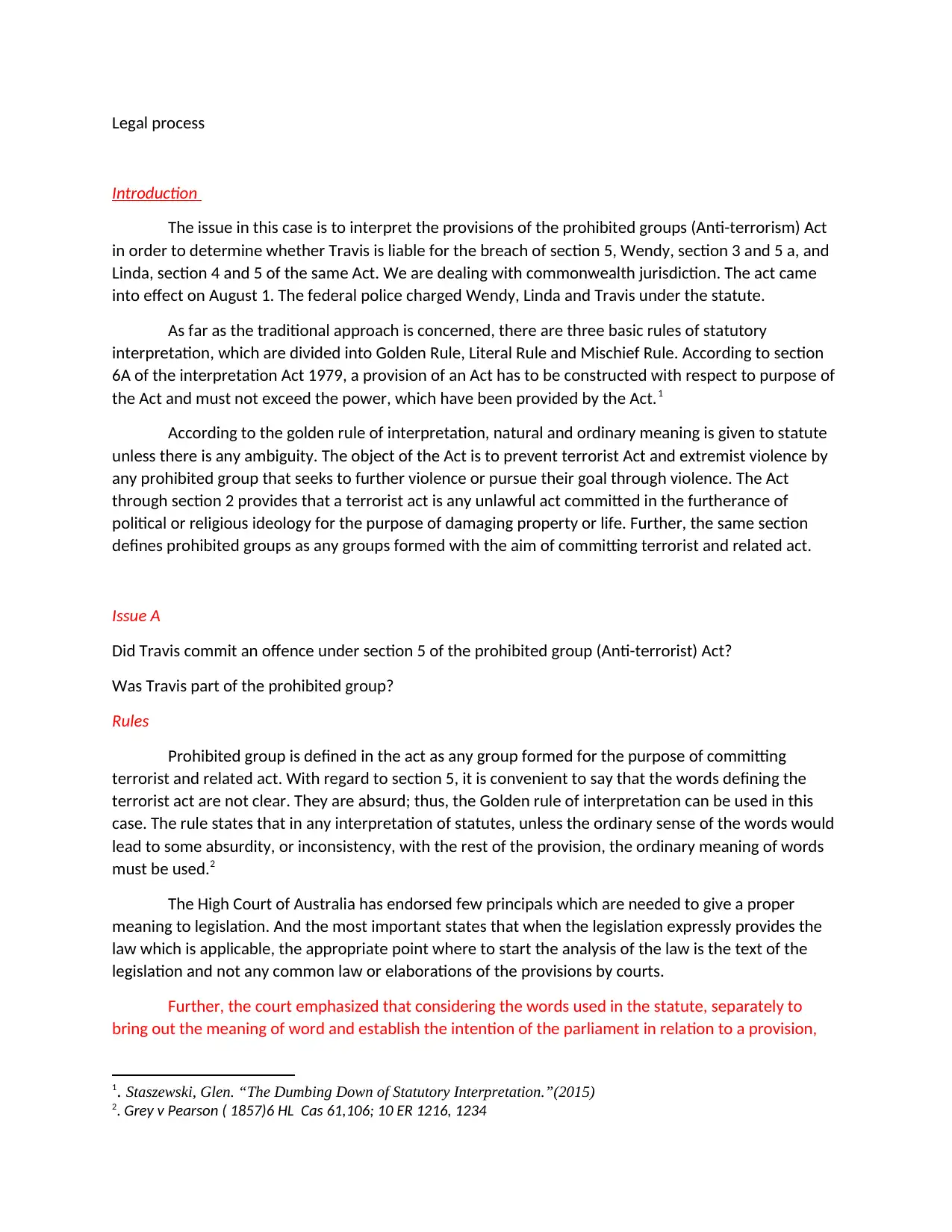
Legal process
Introduction
The issue in this case is to interpret the provisions of the prohibited groups (Anti-terrorism) Act
in order to determine whether Travis is liable for the breach of section 5, Wendy, section 3 and 5 a, and
Linda, section 4 and 5 of the same Act. We are dealing with commonwealth jurisdiction. The act came
into effect on August 1. The federal police charged Wendy, Linda and Travis under the statute.
As far as the traditional approach is concerned, there are three basic rules of statutory
interpretation, which are divided into Golden Rule, Literal Rule and Mischief Rule. According to section
6A of the interpretation Act 1979, a provision of an Act has to be constructed with respect to purpose of
the Act and must not exceed the power, which have been provided by the Act.1
According to the golden rule of interpretation, natural and ordinary meaning is given to statute
unless there is any ambiguity. The object of the Act is to prevent terrorist Act and extremist violence by
any prohibited group that seeks to further violence or pursue their goal through violence. The Act
through section 2 provides that a terrorist act is any unlawful act committed in the furtherance of
political or religious ideology for the purpose of damaging property or life. Further, the same section
defines prohibited groups as any groups formed with the aim of committing terrorist and related act.
Issue A
Did Travis commit an offence under section 5 of the prohibited group (Anti-terrorist) Act?
Was Travis part of the prohibited group?
Rules
Prohibited group is defined in the act as any group formed for the purpose of committing
terrorist and related act. With regard to section 5, it is convenient to say that the words defining the
terrorist act are not clear. They are absurd; thus, the Golden rule of interpretation can be used in this
case. The rule states that in any interpretation of statutes, unless the ordinary sense of the words would
lead to some absurdity, or inconsistency, with the rest of the provision, the ordinary meaning of words
must be used.2
The High Court of Australia has endorsed few principals which are needed to give a proper
meaning to legislation. And the most important states that when the legislation expressly provides the
law which is applicable, the appropriate point where to start the analysis of the law is the text of the
legislation and not any common law or elaborations of the provisions by courts.
Further, the court emphasized that considering the words used in the statute, separately to
bring out the meaning of word and establish the intention of the parliament in relation to a provision,
1. Staszewski, Glen. “The Dumbing Down of Statutory Interpretation.”(2015)
2. Grey v Pearson ( 1857)6 HL Cas 61,106; 10 ER 1216, 1234
Introduction
The issue in this case is to interpret the provisions of the prohibited groups (Anti-terrorism) Act
in order to determine whether Travis is liable for the breach of section 5, Wendy, section 3 and 5 a, and
Linda, section 4 and 5 of the same Act. We are dealing with commonwealth jurisdiction. The act came
into effect on August 1. The federal police charged Wendy, Linda and Travis under the statute.
As far as the traditional approach is concerned, there are three basic rules of statutory
interpretation, which are divided into Golden Rule, Literal Rule and Mischief Rule. According to section
6A of the interpretation Act 1979, a provision of an Act has to be constructed with respect to purpose of
the Act and must not exceed the power, which have been provided by the Act.1
According to the golden rule of interpretation, natural and ordinary meaning is given to statute
unless there is any ambiguity. The object of the Act is to prevent terrorist Act and extremist violence by
any prohibited group that seeks to further violence or pursue their goal through violence. The Act
through section 2 provides that a terrorist act is any unlawful act committed in the furtherance of
political or religious ideology for the purpose of damaging property or life. Further, the same section
defines prohibited groups as any groups formed with the aim of committing terrorist and related act.
Issue A
Did Travis commit an offence under section 5 of the prohibited group (Anti-terrorist) Act?
Was Travis part of the prohibited group?
Rules
Prohibited group is defined in the act as any group formed for the purpose of committing
terrorist and related act. With regard to section 5, it is convenient to say that the words defining the
terrorist act are not clear. They are absurd; thus, the Golden rule of interpretation can be used in this
case. The rule states that in any interpretation of statutes, unless the ordinary sense of the words would
lead to some absurdity, or inconsistency, with the rest of the provision, the ordinary meaning of words
must be used.2
The High Court of Australia has endorsed few principals which are needed to give a proper
meaning to legislation. And the most important states that when the legislation expressly provides the
law which is applicable, the appropriate point where to start the analysis of the law is the text of the
legislation and not any common law or elaborations of the provisions by courts.
Further, the court emphasized that considering the words used in the statute, separately to
bring out the meaning of word and establish the intention of the parliament in relation to a provision,
1. Staszewski, Glen. “The Dumbing Down of Statutory Interpretation.”(2015)
2. Grey v Pearson ( 1857)6 HL Cas 61,106; 10 ER 1216, 1234
Paraphrase This Document
Need a fresh take? Get an instant paraphrase of this document with our AI Paraphraser
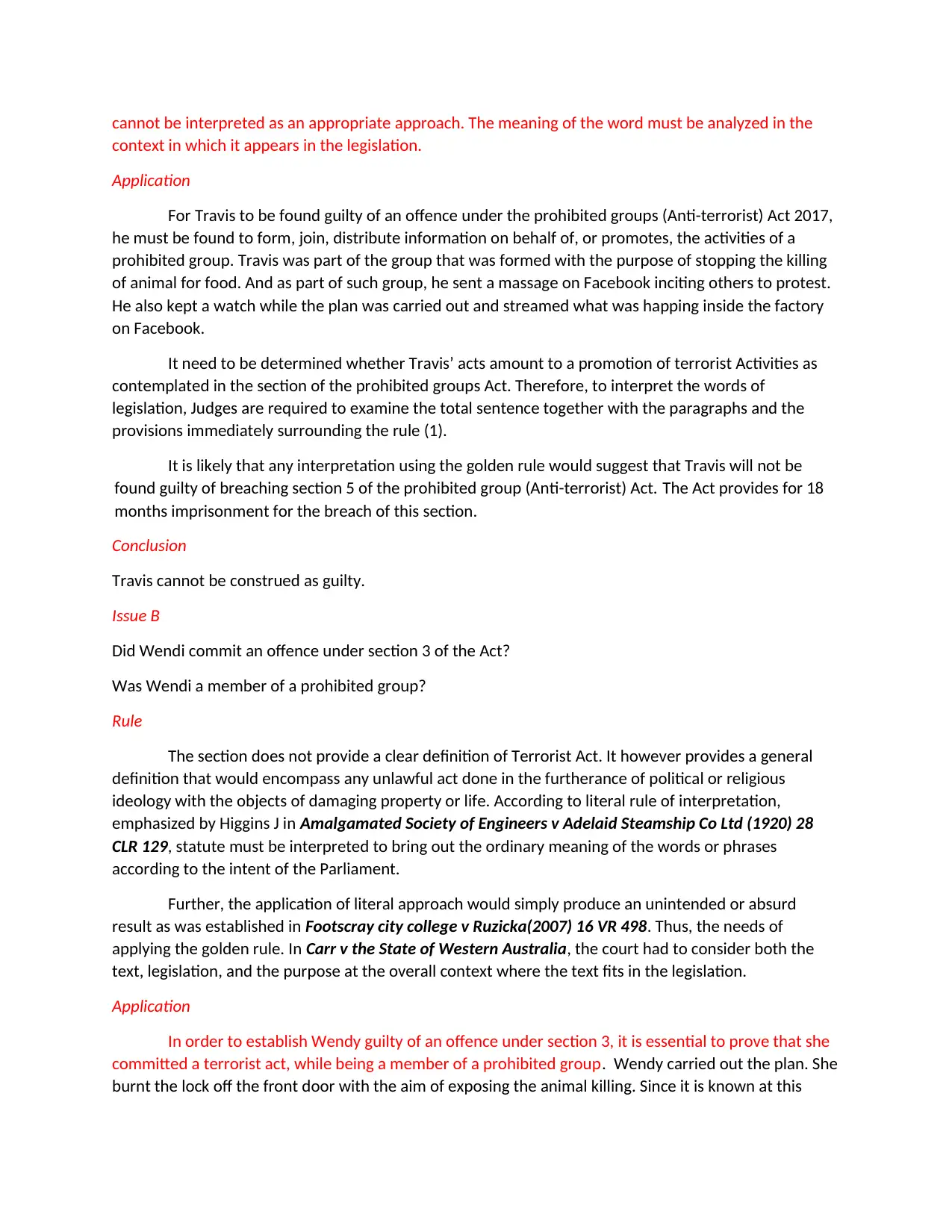
cannot be interpreted as an appropriate approach. The meaning of the word must be analyzed in the
context in which it appears in the legislation.
Application
For Travis to be found guilty of an offence under the prohibited groups (Anti-terrorist) Act 2017,
he must be found to form, join, distribute information on behalf of, or promotes, the activities of a
prohibited group. Travis was part of the group that was formed with the purpose of stopping the killing
of animal for food. And as part of such group, he sent a massage on Facebook inciting others to protest.
He also kept a watch while the plan was carried out and streamed what was happing inside the factory
on Facebook.
It need to be determined whether Travis’ acts amount to a promotion of terrorist Activities as
contemplated in the section of the prohibited groups Act. Therefore, to interpret the words of
legislation, Judges are required to examine the total sentence together with the paragraphs and the
provisions immediately surrounding the rule (1).
It is likely that any interpretation using the golden rule would suggest that Travis will not be
found guilty of breaching section 5 of the prohibited group (Anti-terrorist) Act. The Act provides for 18
months imprisonment for the breach of this section.
Conclusion
Travis cannot be construed as guilty.
Issue B
Did Wendi commit an offence under section 3 of the Act?
Was Wendi a member of a prohibited group?
Rule
The section does not provide a clear definition of Terrorist Act. It however provides a general
definition that would encompass any unlawful act done in the furtherance of political or religious
ideology with the objects of damaging property or life. According to literal rule of interpretation,
emphasized by Higgins J in Amalgamated Society of Engineers v Adelaid Steamship Co Ltd (1920) 28
CLR 129, statute must be interpreted to bring out the ordinary meaning of the words or phrases
according to the intent of the Parliament.
Further, the application of literal approach would simply produce an unintended or absurd
result as was established in Footscray city college v Ruzicka(2007) 16 VR 498. Thus, the needs of
applying the golden rule. In Carr v the State of Western Australia, the court had to consider both the
text, legislation, and the purpose at the overall context where the text fits in the legislation.
Application
In order to establish Wendy guilty of an offence under section 3, it is essential to prove that she
committed a terrorist act, while being a member of a prohibited group. Wendy carried out the plan. She
burnt the lock off the front door with the aim of exposing the animal killing. Since it is known at this
context in which it appears in the legislation.
Application
For Travis to be found guilty of an offence under the prohibited groups (Anti-terrorist) Act 2017,
he must be found to form, join, distribute information on behalf of, or promotes, the activities of a
prohibited group. Travis was part of the group that was formed with the purpose of stopping the killing
of animal for food. And as part of such group, he sent a massage on Facebook inciting others to protest.
He also kept a watch while the plan was carried out and streamed what was happing inside the factory
on Facebook.
It need to be determined whether Travis’ acts amount to a promotion of terrorist Activities as
contemplated in the section of the prohibited groups Act. Therefore, to interpret the words of
legislation, Judges are required to examine the total sentence together with the paragraphs and the
provisions immediately surrounding the rule (1).
It is likely that any interpretation using the golden rule would suggest that Travis will not be
found guilty of breaching section 5 of the prohibited group (Anti-terrorist) Act. The Act provides for 18
months imprisonment for the breach of this section.
Conclusion
Travis cannot be construed as guilty.
Issue B
Did Wendi commit an offence under section 3 of the Act?
Was Wendi a member of a prohibited group?
Rule
The section does not provide a clear definition of Terrorist Act. It however provides a general
definition that would encompass any unlawful act done in the furtherance of political or religious
ideology with the objects of damaging property or life. According to literal rule of interpretation,
emphasized by Higgins J in Amalgamated Society of Engineers v Adelaid Steamship Co Ltd (1920) 28
CLR 129, statute must be interpreted to bring out the ordinary meaning of the words or phrases
according to the intent of the Parliament.
Further, the application of literal approach would simply produce an unintended or absurd
result as was established in Footscray city college v Ruzicka(2007) 16 VR 498. Thus, the needs of
applying the golden rule. In Carr v the State of Western Australia, the court had to consider both the
text, legislation, and the purpose at the overall context where the text fits in the legislation.
Application
In order to establish Wendy guilty of an offence under section 3, it is essential to prove that she
committed a terrorist act, while being a member of a prohibited group. Wendy carried out the plan. She
burnt the lock off the front door with the aim of exposing the animal killing. Since it is known at this
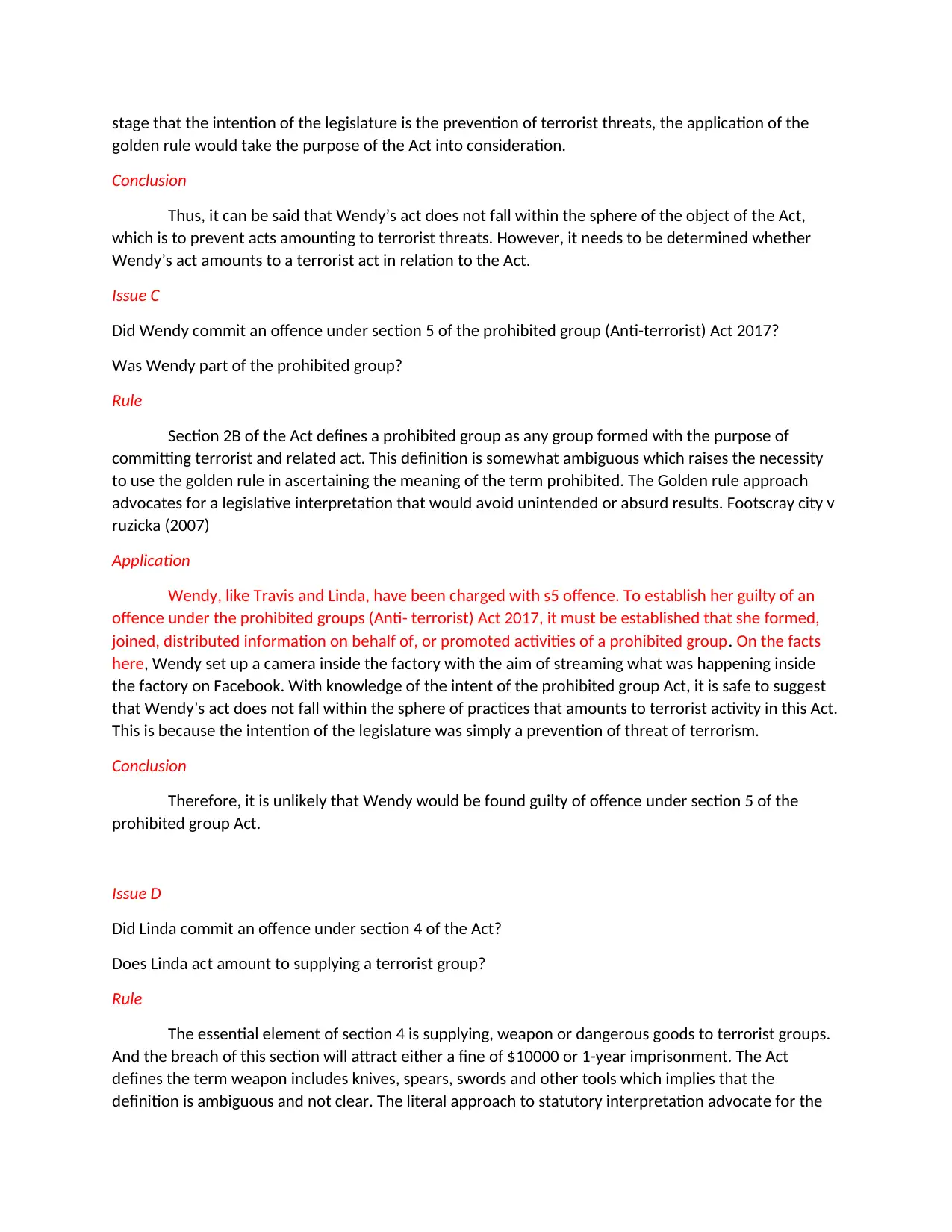
stage that the intention of the legislature is the prevention of terrorist threats, the application of the
golden rule would take the purpose of the Act into consideration.
Conclusion
Thus, it can be said that Wendy’s act does not fall within the sphere of the object of the Act,
which is to prevent acts amounting to terrorist threats. However, it needs to be determined whether
Wendy’s act amounts to a terrorist act in relation to the Act.
Issue C
Did Wendy commit an offence under section 5 of the prohibited group (Anti-terrorist) Act 2017?
Was Wendy part of the prohibited group?
Rule
Section 2B of the Act defines a prohibited group as any group formed with the purpose of
committing terrorist and related act. This definition is somewhat ambiguous which raises the necessity
to use the golden rule in ascertaining the meaning of the term prohibited. The Golden rule approach
advocates for a legislative interpretation that would avoid unintended or absurd results. Footscray city v
ruzicka (2007)
Application
Wendy, like Travis and Linda, have been charged with s5 offence. To establish her guilty of an
offence under the prohibited groups (Anti- terrorist) Act 2017, it must be established that she formed,
joined, distributed information on behalf of, or promoted activities of a prohibited group. On the facts
here, Wendy set up a camera inside the factory with the aim of streaming what was happening inside
the factory on Facebook. With knowledge of the intent of the prohibited group Act, it is safe to suggest
that Wendy’s act does not fall within the sphere of practices that amounts to terrorist activity in this Act.
This is because the intention of the legislature was simply a prevention of threat of terrorism.
Conclusion
Therefore, it is unlikely that Wendy would be found guilty of offence under section 5 of the
prohibited group Act.
Issue D
Did Linda commit an offence under section 4 of the Act?
Does Linda act amount to supplying a terrorist group?
Rule
The essential element of section 4 is supplying, weapon or dangerous goods to terrorist groups.
And the breach of this section will attract either a fine of $10000 or 1-year imprisonment. The Act
defines the term weapon includes knives, spears, swords and other tools which implies that the
definition is ambiguous and not clear. The literal approach to statutory interpretation advocate for the
golden rule would take the purpose of the Act into consideration.
Conclusion
Thus, it can be said that Wendy’s act does not fall within the sphere of the object of the Act,
which is to prevent acts amounting to terrorist threats. However, it needs to be determined whether
Wendy’s act amounts to a terrorist act in relation to the Act.
Issue C
Did Wendy commit an offence under section 5 of the prohibited group (Anti-terrorist) Act 2017?
Was Wendy part of the prohibited group?
Rule
Section 2B of the Act defines a prohibited group as any group formed with the purpose of
committing terrorist and related act. This definition is somewhat ambiguous which raises the necessity
to use the golden rule in ascertaining the meaning of the term prohibited. The Golden rule approach
advocates for a legislative interpretation that would avoid unintended or absurd results. Footscray city v
ruzicka (2007)
Application
Wendy, like Travis and Linda, have been charged with s5 offence. To establish her guilty of an
offence under the prohibited groups (Anti- terrorist) Act 2017, it must be established that she formed,
joined, distributed information on behalf of, or promoted activities of a prohibited group. On the facts
here, Wendy set up a camera inside the factory with the aim of streaming what was happening inside
the factory on Facebook. With knowledge of the intent of the prohibited group Act, it is safe to suggest
that Wendy’s act does not fall within the sphere of practices that amounts to terrorist activity in this Act.
This is because the intention of the legislature was simply a prevention of threat of terrorism.
Conclusion
Therefore, it is unlikely that Wendy would be found guilty of offence under section 5 of the
prohibited group Act.
Issue D
Did Linda commit an offence under section 4 of the Act?
Does Linda act amount to supplying a terrorist group?
Rule
The essential element of section 4 is supplying, weapon or dangerous goods to terrorist groups.
And the breach of this section will attract either a fine of $10000 or 1-year imprisonment. The Act
defines the term weapon includes knives, spears, swords and other tools which implies that the
definition is ambiguous and not clear. The literal approach to statutory interpretation advocate for the
⊘ This is a preview!⊘
Do you want full access?
Subscribe today to unlock all pages.

Trusted by 1+ million students worldwide
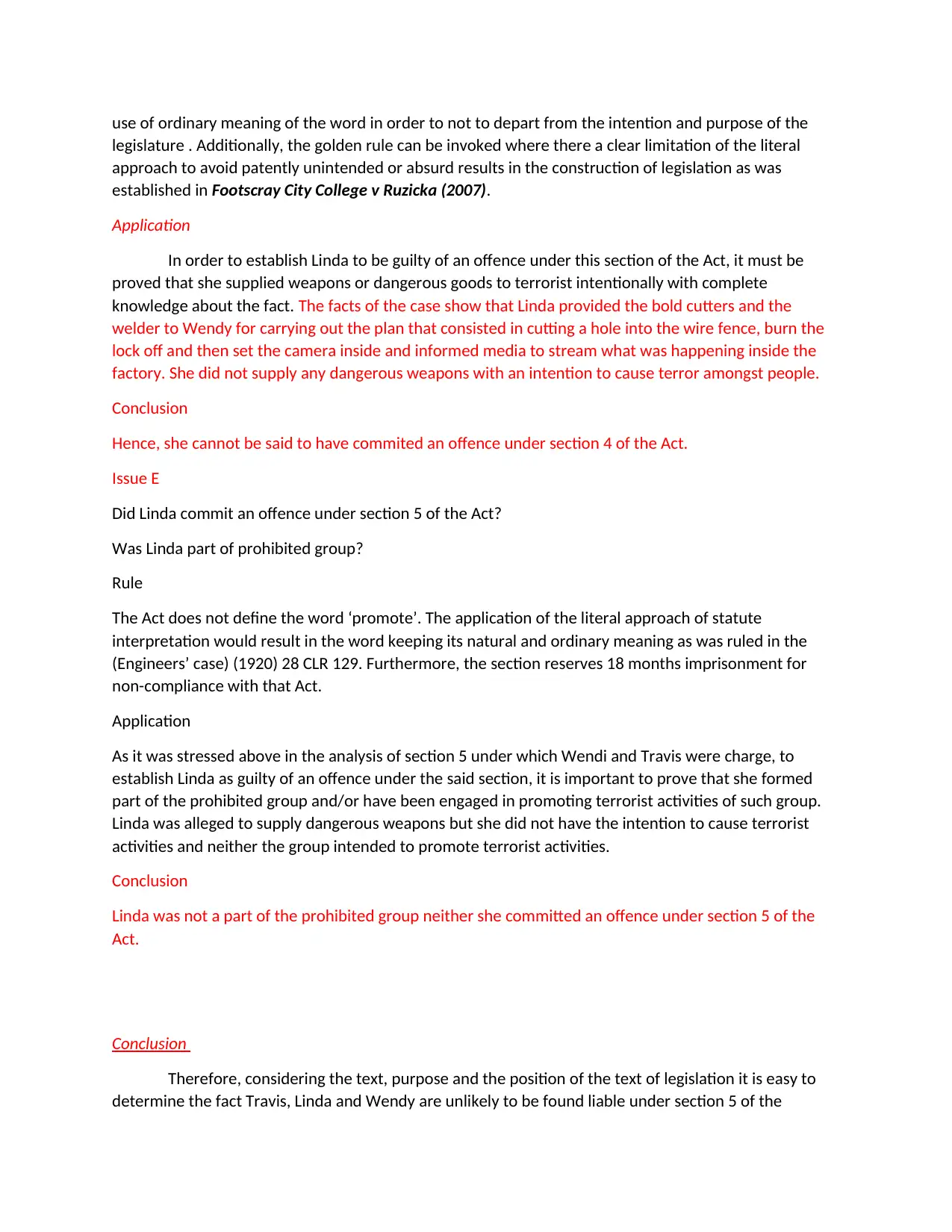
use of ordinary meaning of the word in order to not to depart from the intention and purpose of the
legislature . Additionally, the golden rule can be invoked where there a clear limitation of the literal
approach to avoid patently unintended or absurd results in the construction of legislation as was
established in Footscray City College v Ruzicka (2007).
Application
In order to establish Linda to be guilty of an offence under this section of the Act, it must be
proved that she supplied weapons or dangerous goods to terrorist intentionally with complete
knowledge about the fact. The facts of the case show that Linda provided the bold cutters and the
welder to Wendy for carrying out the plan that consisted in cutting a hole into the wire fence, burn the
lock off and then set the camera inside and informed media to stream what was happening inside the
factory. She did not supply any dangerous weapons with an intention to cause terror amongst people.
Conclusion
Hence, she cannot be said to have commited an offence under section 4 of the Act.
Issue E
Did Linda commit an offence under section 5 of the Act?
Was Linda part of prohibited group?
Rule
The Act does not define the word ‘promote’. The application of the literal approach of statute
interpretation would result in the word keeping its natural and ordinary meaning as was ruled in the
(Engineers’ case) (1920) 28 CLR 129. Furthermore, the section reserves 18 months imprisonment for
non-compliance with that Act.
Application
As it was stressed above in the analysis of section 5 under which Wendi and Travis were charge, to
establish Linda as guilty of an offence under the said section, it is important to prove that she formed
part of the prohibited group and/or have been engaged in promoting terrorist activities of such group.
Linda was alleged to supply dangerous weapons but she did not have the intention to cause terrorist
activities and neither the group intended to promote terrorist activities.
Conclusion
Linda was not a part of the prohibited group neither she committed an offence under section 5 of the
Act.
Conclusion
Therefore, considering the text, purpose and the position of the text of legislation it is easy to
determine the fact Travis, Linda and Wendy are unlikely to be found liable under section 5 of the
legislature . Additionally, the golden rule can be invoked where there a clear limitation of the literal
approach to avoid patently unintended or absurd results in the construction of legislation as was
established in Footscray City College v Ruzicka (2007).
Application
In order to establish Linda to be guilty of an offence under this section of the Act, it must be
proved that she supplied weapons or dangerous goods to terrorist intentionally with complete
knowledge about the fact. The facts of the case show that Linda provided the bold cutters and the
welder to Wendy for carrying out the plan that consisted in cutting a hole into the wire fence, burn the
lock off and then set the camera inside and informed media to stream what was happening inside the
factory. She did not supply any dangerous weapons with an intention to cause terror amongst people.
Conclusion
Hence, she cannot be said to have commited an offence under section 4 of the Act.
Issue E
Did Linda commit an offence under section 5 of the Act?
Was Linda part of prohibited group?
Rule
The Act does not define the word ‘promote’. The application of the literal approach of statute
interpretation would result in the word keeping its natural and ordinary meaning as was ruled in the
(Engineers’ case) (1920) 28 CLR 129. Furthermore, the section reserves 18 months imprisonment for
non-compliance with that Act.
Application
As it was stressed above in the analysis of section 5 under which Wendi and Travis were charge, to
establish Linda as guilty of an offence under the said section, it is important to prove that she formed
part of the prohibited group and/or have been engaged in promoting terrorist activities of such group.
Linda was alleged to supply dangerous weapons but she did not have the intention to cause terrorist
activities and neither the group intended to promote terrorist activities.
Conclusion
Linda was not a part of the prohibited group neither she committed an offence under section 5 of the
Act.
Conclusion
Therefore, considering the text, purpose and the position of the text of legislation it is easy to
determine the fact Travis, Linda and Wendy are unlikely to be found liable under section 5 of the
Paraphrase This Document
Need a fresh take? Get an instant paraphrase of this document with our AI Paraphraser
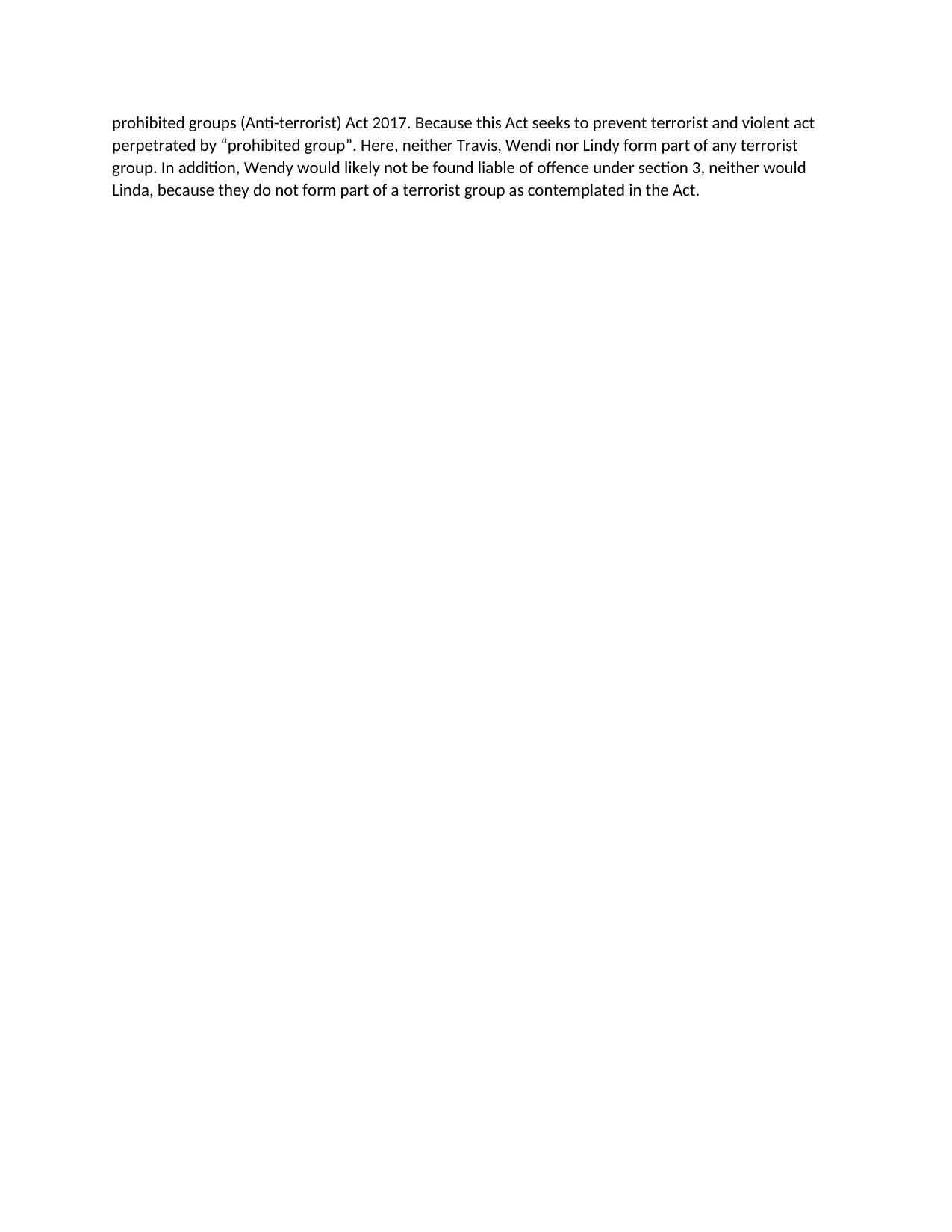
prohibited groups (Anti-terrorist) Act 2017. Because this Act seeks to prevent terrorist and violent act
perpetrated by “prohibited group”. Here, neither Travis, Wendi nor Lindy form part of any terrorist
group. In addition, Wendy would likely not be found liable of offence under section 3, neither would
Linda, because they do not form part of a terrorist group as contemplated in the Act.
perpetrated by “prohibited group”. Here, neither Travis, Wendi nor Lindy form part of any terrorist
group. In addition, Wendy would likely not be found liable of offence under section 3, neither would
Linda, because they do not form part of a terrorist group as contemplated in the Act.
1 out of 5
Related Documents
Your All-in-One AI-Powered Toolkit for Academic Success.
+13062052269
info@desklib.com
Available 24*7 on WhatsApp / Email
![[object Object]](/_next/static/media/star-bottom.7253800d.svg)
Unlock your academic potential
Copyright © 2020–2025 A2Z Services. All Rights Reserved. Developed and managed by ZUCOL.





